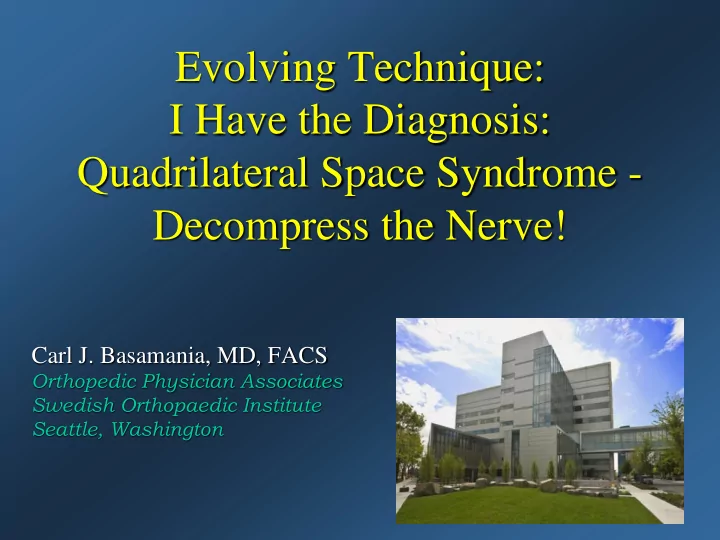

Evolving Technique: I Have the Diagnosis: Quadrilateral Space Syndrome - Decompress the Nerve! Carl J. Basamania, MD, FACS Orthopedic Physician Associates Swedish Orthopaedic Institute Seattle, Washington
Presenter Disclosure Information Carl J. Basamania, MD, FACS Disclosure Information The following relationships exist: DePuy/Johnson and Johnson: Consultant, Royalties Zimmer/Biomet: Consultant, Royalties Sonoma Orthopaedics: Consultant, Royalties Invuity: Consultant, Stock Options BioPoly: Consultant, Stock Options Nothing of value received for this presentation No “off label” use of any products
Case • 41 year old RHD male concert “rigger” – Mistaken for backstage “trespasser” and arrested – right arm forcefully pulled behind back – Has to lift 50-150 pound lighting up to stage scaffolding using a “hand over hand” technique – 6 months after “arrest” complains of posterior right shoulder pain and weakness
PE • Full ROM • Tenderness posterior lower scapular region • 4-4+/5 external rotation strength • ++O’Brien’s • Pain exacerbated by resisted “cocking motion”
Background • Quadrilateral space syndrome –Relatively rare condition –Typically young athletic adults 25 to 35 years without a history of significant trauma –True prevalence is unknown
Background • Teres minor atrophy or abnormal signal may be present in as many as 0.8% (19/2436) of patients referred for shoulder MRI – AJR. 2005;184: 989-992. 10.2214/ajr.184.3.01840989
Background • The boundaries of the quadrilateral space are: – the shaft of humerus – teres minor – long head of triceps – teres major • Cadaveric study showed nerve to the teres minor was found to have branched either in or before the quadrilateral space JSES 2008,17(1),162-164
Pathophysiology •Mechanism of injury •compression and reduction of quadrangular space due to •iatrogenic (tight fibrous bands, muscular hypertrophy) •paralabral cysts (most commonly inferior labral tears) •trauma (scapular fracture, shoulder dislocation) •benign or malignant masses •Pathomechanics •greatest amount of compression occurs when the arm is positioned in the late cocking phase of throwing (abduction and external rotation)
Differential Diagnosis • Rotator cuff tear • Paralabral ganglion • Suprascapular neuropathy • Parsonage-Turner Syndrome • Thoracic outlet syndrome • Scapula Fxs
Evaluation • MRI – Diagnostic • EMG • US • Arteriography – Seldom used anymore – Vascular occlusion can be seen in ~80% asymptomatic patients • AJR Am J Roentgenol 1994;163:625–7
MRI Results
MRI Results
MRI Results
MRI Results
MRI Results
Treatment Alternatives • PT • Analgesics/NSAID’s • Rest/avoidance of athletic activities • Deep soft tissue massage • Stretching • Surgery – acute and nonresponsive cases
Surgery • Arthroscopy – Patient had degenerative SLAP – Debridement and tenodesis • Open quad space release JSES, 2015. 24(4),628–633. doi.org/10.1016/j.jse.2014.08.018
Surgery • Posterior midaxillary incision • Incise dense deltoid fascia along inferior border of deltoid • Retract deltoid superolateral • Abducting and externally rotating arm relaxes deltoid
Surgery • Open interval between teres major and teres minor • Open fascia over teres minor to quadrilateral space • Identify and decompress axillary nerve
Follow-up • 6 months postop • No pain • External rotation strength normal • Lawsuit pending against arresting security guard
Published Results • Few large studies • 22 patients, follow-up 26 months. • 9 patients had concurrent procedures • Preoperatively, 12 of 14 (86%) had external rotation weakness in Horn blower's position • Postoperatively, pain scores decreased an average of 4 points; ASES scores increased 31.7 ± 20.2 points; SST scores increased 3.1 ± 2.3 points. • No external rotation weakness was noted postoperatively in any tested patient. • Two patients developed adhesive capsulitis. JSES, 2015. 24(4),628–633. doi.org/10.1016/j.jse.2014.08.018
Recommend
More recommend